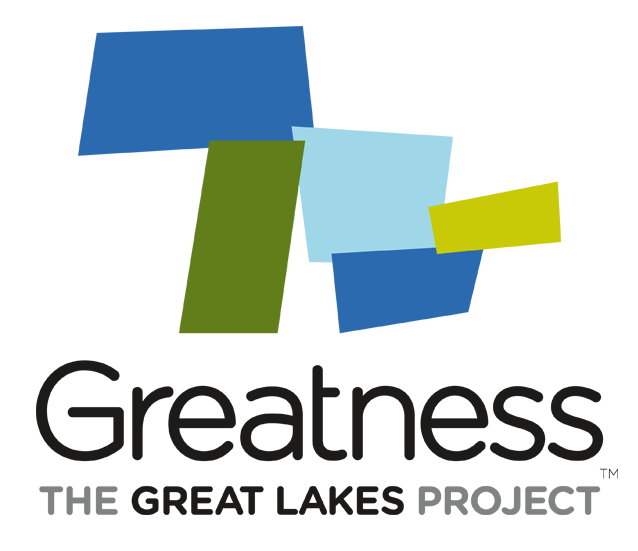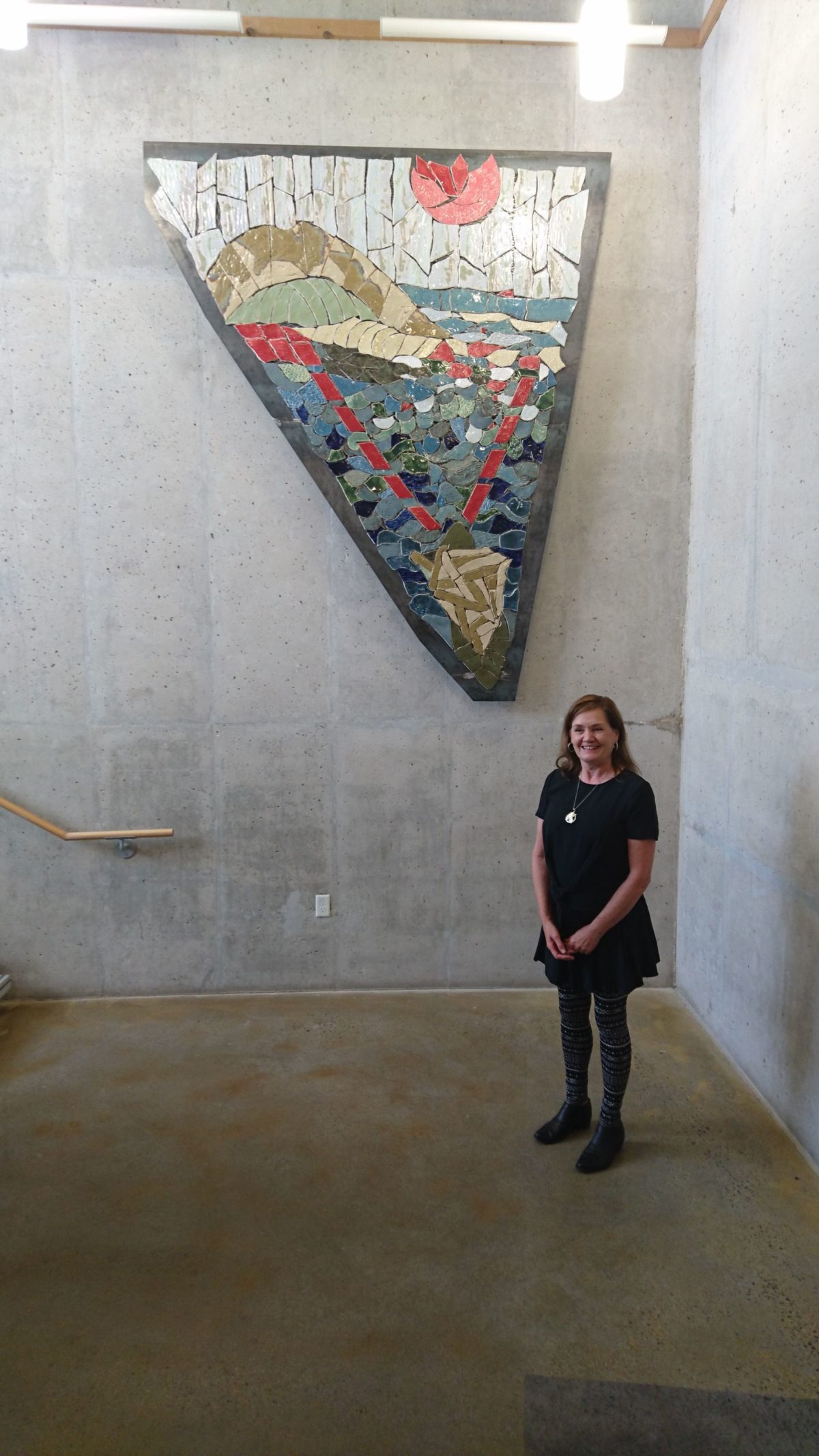
This week, we’re featuring a spot from our Great Art for Great Lakes artists.
GAGL sat down with Kingston artist, Andy Berg to discuss her completed Great Art for Great Lakes piece, Aqua Viva, her experience creating community-engagement artwork, and what she’s working on these days.
GAGL: Who is Andy Berg? Tell us a bit about yourself.
I am an early career sculptor with an abiding interest in the beauty and wellness of the water and land of my locale. I see my art practice as a holistic, consciousness building project, for myself and for interested others. I am a devoted walker on the land and am in love with trees, rocks and water.
 I am of Nordic background and came to Canada as a toddler, returned to Denmark briefly and settled back in Canada at the start of Kindergarten. I have been here ever since, grew up, overcame many challenges, had my children in Kingston where I still reside with my spouse, special education secondary school teacher, Meredith Wright and am steadily building a discursive art practice since graduating as a mature student from Queen’s BFAH. I am inspired and influenced by Scandinavian progressive values and I am strongly attached to the land, having played in the country fields near Ottawa.
I am of Nordic background and came to Canada as a toddler, returned to Denmark briefly and settled back in Canada at the start of Kindergarten. I have been here ever since, grew up, overcame many challenges, had my children in Kingston where I still reside with my spouse, special education secondary school teacher, Meredith Wright and am steadily building a discursive art practice since graduating as a mature student from Queen’s BFAH. I am inspired and influenced by Scandinavian progressive values and I am strongly attached to the land, having played in the country fields near Ottawa.
My home is in Portsmouth Village and I can see Lake Ontario down the street each morning that I walk out my front yard. It is an amazing privilege to see Lake Ontario on a daily basis and I am very connected to its energies, with each day and each season bringing new vistas from it’s beautiful waters.
Andy Berg is a nom de plume for my art practice and my full name is Anna Eliesa Elmberg Wright—way too long… The shortened name partly reflects my inner tomboy from childhood—running in cornfields, climbing up haystacks, building elaborate snow forts, sneaking raspberries from the neighbouring gardens (that part’s a secret).
“…a project such as Great Art for Great Lakes can give birth to expanded community engagement and collective commitment to the gift of water in our wonderful lakes.”
GAGL: What interested you about the Great Art for Great Lakes proposal?
I am a fan of Lake Ontario. As an adult, I have lived in three different Lake Ontario locations of Port Hope, Bath and Kingston over the years. The water from Lake Ontario is coursing through my veins and I acknowledge it as a major source of life and emotional sustenance. I walk along its shores regularly for both recreation and art, especially along the waterfront trail near Portsmouth Village and trails at LeMoine Point Park. To me these walks are a form of creative pilgrimage and bonding with the Lake. I became interested in the Great Art for Great Lakes project for I saw it as way to marry my concern for the health of our Great Lake environment, my appreciation of the unique beauty and richness of the Great Lakes as a tremendous gift of Nature; my sense that our collective culture needs to experience tactile and visual moments that gently build haptic awareness, care and active commitment to our sources of water; my excitement about the potential of co-creating a visual platform about the Lake via Aqua Viva in order to simultaneously represent a community process and a work of art in clay for the purpose of sharing and communicating with others about our Great Lakes. My interest in the Great Art for Great Lakes proposal was motivated by these factors. I feel that these can form a foundation that will help to deepen the Kingston community connection to Lake Ontario and to the waters beyond it; that a project such as Great Art for Great Lakes can give birth to expanded community engagement and collective commitment to the gift of water in our wonderful lakes.

Great Food, Great Lakes Event at the Tett Centre.
GAGL: What was it like leading clay-making workshops for adults and children?
It was a lovely experience to lead clay-making workshops with the Kingston community. The participants were very responsive to the process based approach that I utilized for leading them into an engagement with the subject of Lake Ontario. This was also done through the artistic mediums of a shoreline discovery walk as well as creative workshop processes: guided visualization, text based pen and ink washes, analyzing lake shoreline debris objects both natural and human-made, and finally of getting hands messy through the use of the really earthy materials of clay and water to make community elements for Aqua Viva ceramic wall work. Clay and water are the very tactile materials that helped to connect the participants to the gravity and joy of the subject of the Great Lakes in a manner that simultaneously fostered both serious reflection and a fun kind of freedom to play. The final result of the finished work is very physical and tactile and speaks both of and to our Lake Ontario. Having had the opportunity to hold creative community space and have others participate in this artistic and empowering process has been very illuminating and enriching to me as an artist. It is an experience which I will carry forth in future public art projects.
“Clay is an amazing material. It captivates people and they love fooling around with it… This play and awareness contributed to the deepening of the whole clay making experience in a profound manner that helps to facilitate serious ideas, visons and ties to our Lake.”

Clay-making Workshop at the Tett Centre
GAGL: What were your favourite moments during the process of creating Aqua Viva?
The Lake Ontario Shoreline Discovery Walk as a process of walking with a small community group along the shoreline, uses exercises to feel the energy of the lake, sharing stories and histories of the Lake, enjoying the tremendous presence of the Lake, sharing concerns and experiences participants have had about the Lake and then reflecting upon this collectively.
The community diving in and making clay stamps about Lake Ontario for use on Aqua Viva at the GAGL opening event for Kingston was delightful. Clay is an amazing material. It captivates people and they love fooling around with it. Even neophytes got lost in the clay making process. The wonderful way that clay helped the participants to detach from their daily concerns and to have a time of play, of mucking around. This is rare, especially for adults in our hurried culture. Working with clay is a very intimate yet grounding experience. It ultimately brings people back into their bodies and thus into a place of greater awareness. This play and awareness contributed to the deepening of the whole clay making experience in a profound manner that helps to facilitate serious ideas, visons and ties to our Lake.
The three GAGL Clay Maker Event sessions for the stoneware clay wall work were very rewarding. Once again the participants showed a great level of imagination, creativity and engagement with the processes around making clay elements for the Aqua Viva wall work. It was rewarding to witness the Kingston community’s high level of commitment to the subject and concerns of Lake Ontario while maintaining a sense of fun and comradery in the clay making process.
“Increasingly, my art practice is critically invested in participant engagement and this can range from inviting others help to curate a sculpture installation while I step out of the way and simply allow/observe what unfolds; to utilizing meditative visualization processes with participants as a way to enter a creative or imaginal space.”

Aqua Viva in process.
GAGL: In addition to Aqua Viva, what are the other types of art that make up your body of work?
My work in sculpture since graduating in 2008 from Queen’s, has tended to focus on the artistic practice of walking in my environment and engaging in intuitive methods of random discovery and by chance gathering of debris objects which are then integrated into sculpture and installations. This work tends to be descriptive or reflective of the incursions human stuff and actions have made into the environment, while also exploring the manifestations of consciousness. I think of these reflective descriptors as being symptoms of the disease of instrumental or material culture. In recent years my work as an emerging artist has been shown at the Canadian Sculpture Centre in Toronto; Verb Gallery, Kingston; Modern Fuel Artist Run Centre, Kingston; Oeno Sculpture Garden, Bloomfield; Temiskaming Art Gallery, Haileybury; J.B. Aird Gallery, Toronto.
I also have a background in Therapeutic Touch and Classical Homeopathy and have studied and worked clinically with both people and animals in these areas. So I am interested in using holistic modalities as tools in my art along with the aforementioned intuitive methods. Over the past couple of years, I have been developing ways to work beyond just speaking about cultural duality and dis-ease symptoms in my sculpture. Increasingly, my art practice is critically invested in participant engagement and this can range from inviting others help to curate a sculpture installation while I step out of the way and simply allow/observe what unfolds; to utilizing meditative visualization processes with participants as a way to enter a creative or imaginal space. This facilitates participant separation from their current engagement with the ever present minutiae of technocratic capitalist life and is a means of accessing a space for example, of hope, empathy, or/and interconnection. A recent example of this was my workshop for Queen’s Backing Action On Climate Change student group, March 2017 (and which I plan to offer to other groups over the coming year) for the purpose of co-creating a cumulative floor work in clay entitled Cellular, on the subject of cells, human health and planetary wellness.

Aqua Viva Unveiling, the Tett Centre
GAGL: If there were not any constraints, what would your dream project be?
How about this: A nice big public art project that interconnects with the environment and the diverse inhabitants of a given locale; a biocentric project that provides an opportunity for reflective circumambulation by visitors; that integrates art, holism and Nature in order to foster haptic intelligence and advance consciousness and calm. It would be a genius loci project embodying beauty for and with the visitors in a manner that implicates them in the work and which serves to link all stakeholders, including Nature herself. This kind of project would entail the art and process of engaging and guiding the jury/governing body and participants/stakeholders (the public and the environment), in a brave, collaborative and co-creative process of dreaming, imagining and visioning an integrative, interactive public art project actualized physically in for example, a park, a wild or abandoned area, or even a public square.

